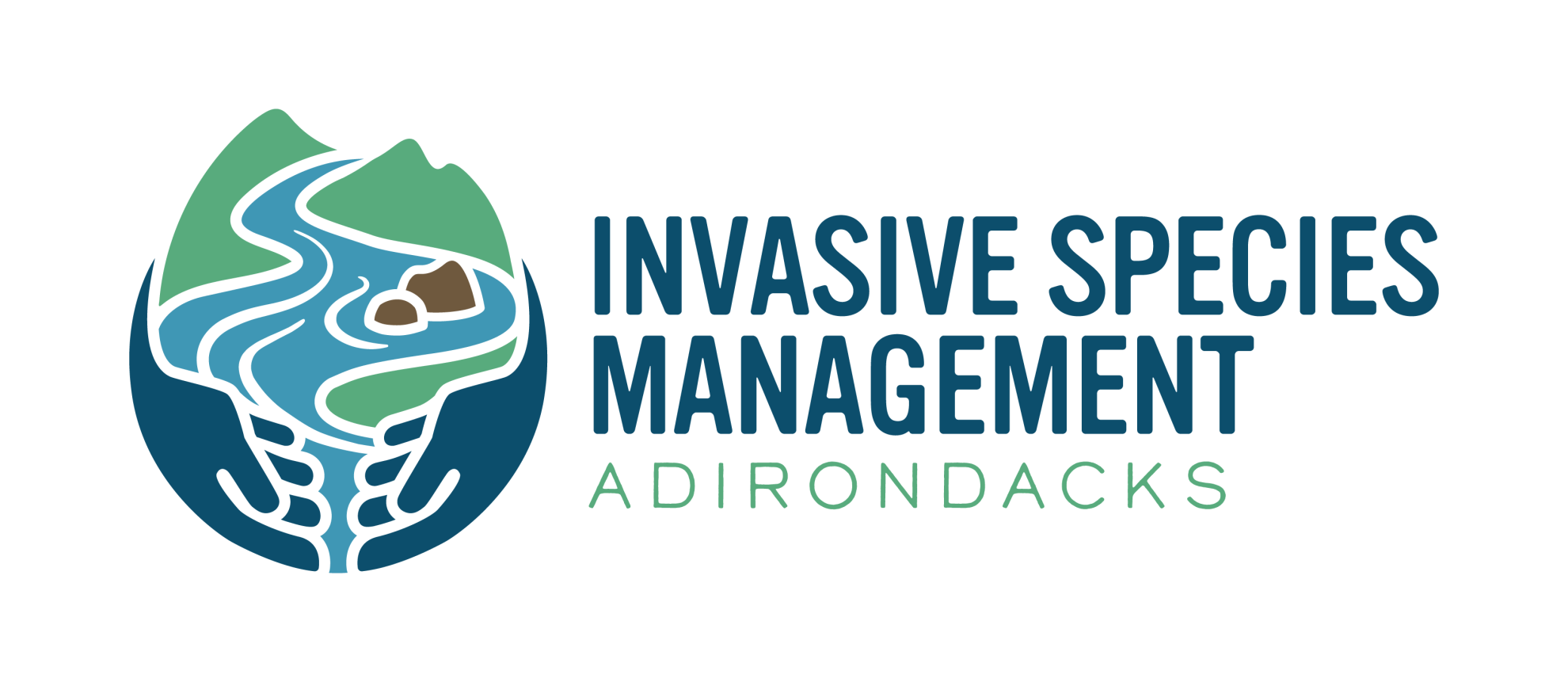All About Knotweed
What is it?
Invasive knotweed is a large, perennial invasive shrub native to Asia. There are three similar species of invasive knotweed frequently encountered in the Adirondacks including Japanese knotweed (Reynoutria japonica), giant knotweed (Reynoutria sachalinensis), and a hybrid of the two known as Bohemian knotweed (Reynoutria × bohemica). While the species are unique, they are very similar in appearance and impact.
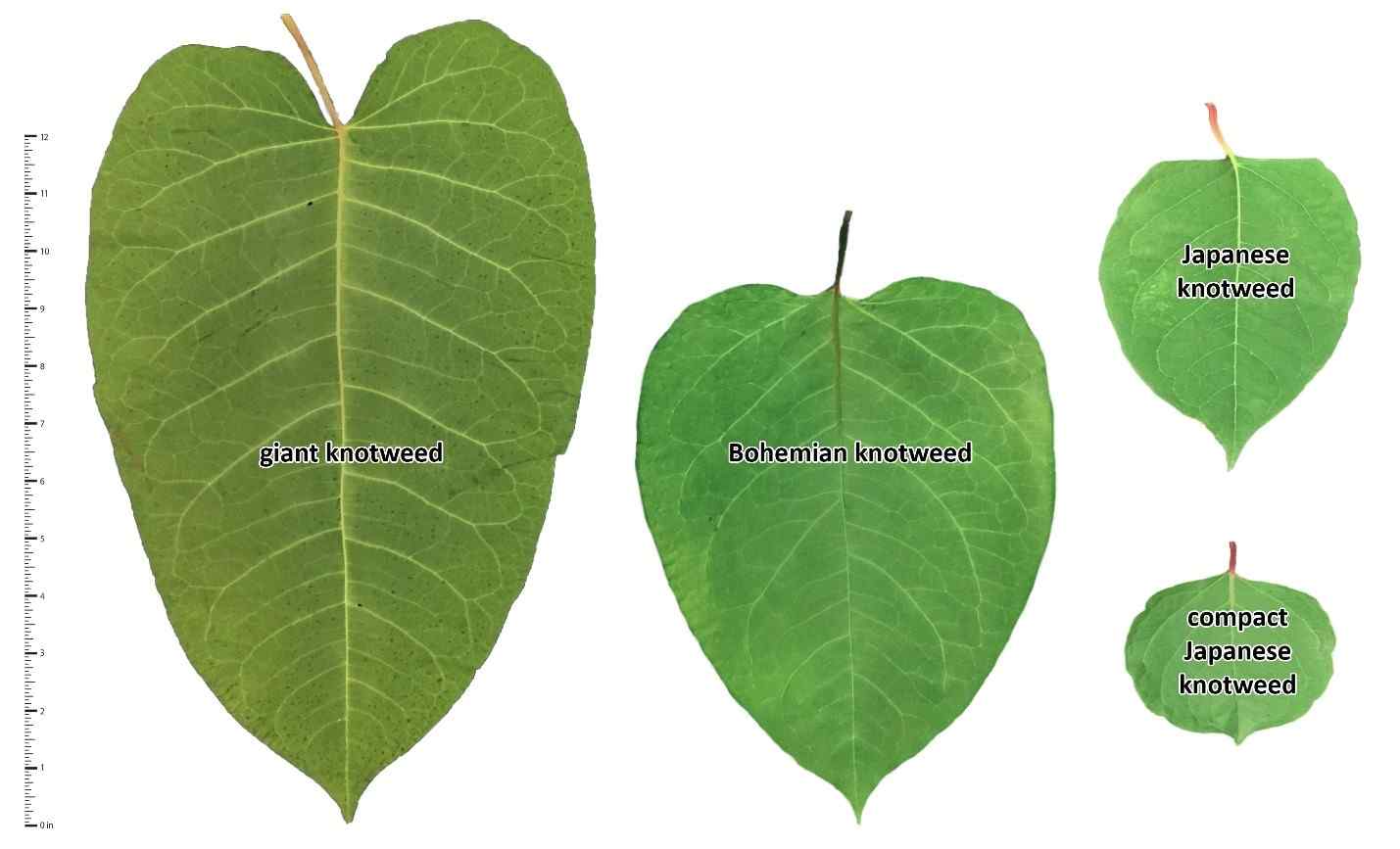
Photo Credit: Minnesota Department of Agriculture.
What are the key identifying features?
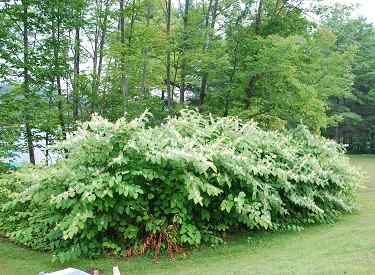
Form
Knotweed is a large, densely growing herbaceous shrub. At peak growth, an established plant may exceed 12 feet in height.
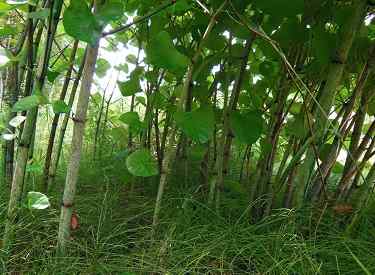
Stems
Stems are stout and cane like, resembling a bamboo species. They are hollow and green, and are sometimes covered with red spots or blotches. Raised ridges (nodes) are found along the length of each stem.
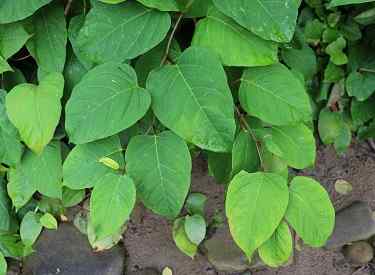
Leaves
Leaf shape is variable by species (see above) but is typically heart- or spade- shaped. Leaf size can differ signifcantly between species and sites, with some leaves exceeding 12 inches in length.
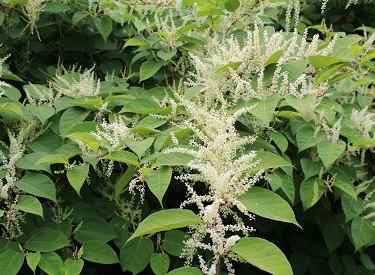
Flowers
Knotweed produces large clusters of small white flowers at the ends of its branches. Plants typically bloom August to September.
How does it spread?
Knotweed spreads primarily through the expansion of an extensive underground root system. The lateral roots (rhizomes) of knotweed are fast growing and aggressive. They can extend 30+ feet horizontally from where plants are visible above ground. Rhizomes produce new plant shoots, expanding the size of the knotweed infestations. Rhizomes and stems are very durable, sometimes emerging through asphalt or concrete.
Knotweed can also be easily spread through the fragmentation of its roots or aboveground stems. If the plant parts are broken apart -- such as by a mower along a roadside or a flood near a river -- each piece of knotweed can produce rootlets and establish a new infestation.
What's the big deal?
Knotweed presents multiple ecological, environmental and societal impacts to landowners, natural resource practitioners and transportation professionals. For example, dense infestations of knotweed exclude native plant species, reducing biodiversity in natural systems and limiting habitat for native animals. When established along a roadside or driveway, tall knotweed plants can impede line of sight or block road signs creating hazards for motorists. The root system of knotweed does not grow as deeply as native plants in the same habitat, which leads to increased erosion when knotweed is established along rivers and streams. Bottom line -- this plant is bad news.
Invasive Knotweed Management
Invasive knotweed is one of the most difficult invasive species to control. There is no single, quick fix to manage knotweed on your property. In many cases, a variety of techniques will be required and will need to be repeated for several years. Large or established patches of knotweed may require some level of maintenance management in perpetuity.
Management Techniques
- Using a digging tool, carefully remove the entire plant and its root system.Small plants may be hand pulled depending on soil conditions and the stage of root development.
- Remove excess soil from the root ball, taking care to not break apart the rhizome system.
- Inspect the area where the knotweed was removed for any residual rhizome or root material; remove if detected.
- Place all plant material in a black plastic bag and solarize by placing the bag in the sun for at least two weeks before disposal in a landfill.
- Stem injection - using a specialized injection tool, a small dose (2-5ml) of concentrated (100%) glyphosate based herbicide is delivered directly inside the hollow cavity of each stem. This technique is extremely selective and effective, but laborious. It is best used for small patches, isolated stems, or where there is a high risk for off-target impact with other application techniques. Don't have an injection tool? No problem! APIPP administers a knotweed stem injection tool loaner program to loan this specialized equipment to landowners at no charge. Contact us to learn more.
- Foliar Spray - using a backpack or hand-held sprayer, a diluted (1.5-3%) solution of glyphosate based herbicide is selectively applied to the foliage of knotweed. This is the most efficient technique to treat large or dense infestations. While it is quick and efficient, this method presents a higher potential for off-target impacts via herbicide spray drift. Foliar spray treatments should be performed under favorable environmental conditions (i.e.. low wind).
Herbicide Application Timing
The herbicides used to control knotweed are systemic, meaning they are absorbed by the plant and transported throughout its circulatory system. Ideally, herbicide applications should be performed late in the growing season while plants are flowering. At this time, knotweed is actively moving nutrients into its root system to prepare for winter dormancy. Systemic products will also be carried into the root system, providing effective control. All treatments should be completed at least two weeks before the first anticipated frost. The figure below provides an overview of knotweeds life cycle and indicates the optimal times for management.
Do it Yourself
With the right tools and techniques, you can manage knotweed on your own property. To learn more, check out our Landowners Guide to Knotweed Control.

